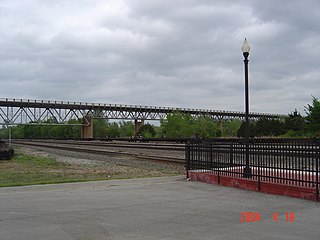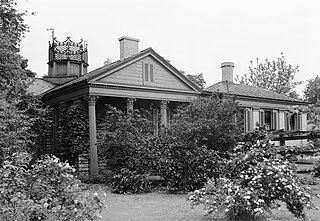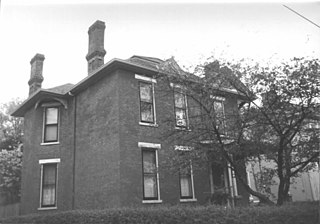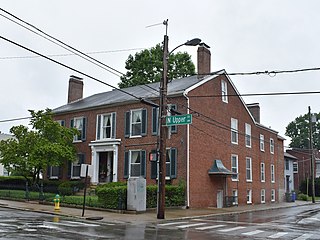
Lexington is a city in Kentucky, United States that is the county seat of Fayette County. By population, it is the second-largest city in Kentucky and 57th-largest city in the United States. By land area, it is the country's 28th-largest city. The city is also known as "Horse Capital of the World". It is within the state's Bluegrass region. Notable locations in the city include the Kentucky Horse Park, The Red Mile and Keeneland race courses, Rupp Arena, Central Bank Center, Transylvania University, the University of Kentucky, and Bluegrass Community and Technical College.

James Lane Allen was an American novelist and short story writer whose work, including the novel A Kentucky Cardinal, often depicted the culture and dialects of his native Kentucky. His work is characteristic of the late 19th-century local color era, when writers sought to capture the vernacular in their fiction. Allen has been described as "Kentucky's first important novelist".

Lexington Cemetery is a private, non-profit 170-acre (69 ha) rural cemetery and arboretum located at 833 W. Main Street, Lexington, Kentucky.

Crescent Hill is a neighborhood four miles (6 km) east of downtown Louisville, Kentucky USA. This area was originally called "Beargrass" because it sits on a ridge between two forks of Beargrass Creek. The boundaries of Crescent Hill are N Ewing Ave to the St. Matthews city limit by Brownsboro Road to Lexington Road. Frankfort Avenue generally bisects the neighborhood.

Waveland State Historic Site, also known as the Joseph Bryan House, in Lexington, Kentucky is the site of a Greek Revival home and 10 acres now maintained and operated as part of the Kentucky state park system. It was the home of the Joseph Bryan family, their descendants and the people they enslaved in the nineteenth century. Bryan's father William had befriended Daniel Boone and they migrated west through the Cumberland Gap.

Gratz Park is a neighborhood and historic district located just north of downtown Lexington, Kentucky. It was named after early Lexington businessman Benjamin Gratz whose home stands on the corner of Mill and New streets at the edge of Gratz Park. The Gratz Park Historic District consists of 16 contributing buildings including the Hunt-Morgan House, the Bodley-Bullock House, the original Carnegie Library in Lexington, and several other private residences. Gratz Park occupies a tract of land that was established in 1781 outside the original boundaries of Lexington.

The US 77 James C. Nance Memorial Bridge connecting Purcell and Lexington was originally built as a circa 1938 deck truss two-lane bridge and in 2019 rebuilt as a concrete pier four-lane bridge crossing the Canadian River between Purcell and Lexington, Oklahoma. The bridge designated on the list of state highways in Oklahoma carries U.S. Route 77 (US-77) and Oklahoma State Highway 39 (SH-39) from McClain County to Cleveland County. The bridge is named for James C. Nance, longtime community newspaper chain publisher and Speaker of the Oklahoma House of Representatives, President pro tempore of the Oklahoma Senate and member of U.S Uniform Law Commission.

John McMurtry was a 19th-century American builder and architect who worked in Lexington, Kentucky designing a number of notable buildings, several of which are listed on the National Register of Historic Places.

Woodward Heights is a neighborhood and historic district located immediately west of downtown Lexington, Kentucky. It is bounded by Maxwell Street and the Pleasant Green Hill neighborhood to the southwest, by the parking lot for Rupp Arena to the southeast, by the Lexington Convention Center property to the northeast, and by Herlihy, Cox, and High Streets to the north.

James J. Gaffney, most often known as J. J. Gaffney, was an American architect in Louisville, Kentucky.
The Buford-Duke House is antebellum house located in Scott County, Kentucky.

Catlettsburg is a former Chesapeake and Ohio Railroad station located in downtown Catlettsburg, Kentucky. Opened between 1897 and 1890 to replace an older wooden station, it served trains until 1958. Amtrak trains began stopping at Tri-State Station some 1.5 miles (2.4 km) to the north in 1975; it was renamed Catlettsburg around 1988. Amtrak service was moved from Catlettsburg to Ashland in 1998. The C&O station was refurbished from 2004 to 2006 and added to the National Register of Historic Places in 2012.

The Abraham Barton House in Lexington, Kentucky, is a 2+1⁄2-story Greek Revival structure dating from 1795. The house was constructed in multiple stages, and the original dwelling faced Second Street. Architect Gideon Shryock is credited both for the Greek Revival expansion and remodel in the early 1830s and for changing the front exposure to face North Upper Street. The House was added to the National Register of Historic Places in 1977.

The Fayette Safety Vault and Trust Company Building in Lexington, Kentucky, is a commercial building designed by Herman L. Rowe and constructed in 1890. The stone facade was described as "a strange but compelling mixture of Italianate, Neo-Greek, Gothic, and Romanesque motifs," and "not excelled in appearance by any building in Kentucky." It was added to the National Register of Historic Places in 1980.

Monsieur Giron's Confectionery in Lexington, Kentucky, is a 2-story Greek Revival building constructed of brick in 1829. The building replaced an earlier wood frame building at the site, also occupied by Monsieur Giron's Confectionery. A 50-ft ballroom on the second floor was partitioned by folding doors into two spaces. Originally seven bays wide, only three bays in the north half of the building remain. The building's remnant was added to the National Register of Historic Places (NRHP) in 1974.

The Opera House and Yates Bookshop Building in Lexington, Kentucky, are adjacent buildings listed together on the National Register of Historic Places in 1975, and they are contributing resources in the North Broadway-Short Street Historic District.

The Lexington Herald Building, also known as the Nunn Building, in Lexington, Kentucky, is a 4-story commercial structure designed by Leon K. Frankel of Frankel & Curtis and constructed in 1917 as headquarters of the Lexington Herald. F. Paul Anderson, dean of the College of Engineering at University of Kentucky, where Frankel was also a professor, consulted on the steel frame of the brick building. The building's ornamentation is minimal, and it includes a denticulated cornice above the fourth floor windows and a parapet. There is a gable in the parapet in the front center holds a decorative scroll displaying an "H". The building was added to the National Register of Historic Places in 1982.

The Higgins Block, also known as the Fayette Cigar Store, in Lexington, Kentucky, is a 3-story brick building designed by John McMurtry and constructed in 1872. The cast iron, Italianate facade originally contained five storefronts on West Main Street, each with three window bays. The surviving 2-storefront building is a remnant of the original commercial block, shortened in 1912 when construction of the Fayette National Bank Building required demolition of part of the Higgins Block. The remains of the Higgins Block were added to the National Register of Historic Places in 1977.

The Dr. Walter Warfield Building in Lexington, Kentucky, is a Second Empire or Georgian building constructed in 1806 on a corner of Jordan's Row, a string of buildings constructed or owned by John Jordan. Originally two stories, the brick building was expanded in 1870 with a third story that includes a Mansard roof and dormers. A later expansion added a 2-story annex to the building.
The Bates Log House, also known as "Bates House", at 5143 Spurr Rd. in Lexington, Kentucky, was built around 1800. It was listed on the National Register of Historic Places in 1982.




















